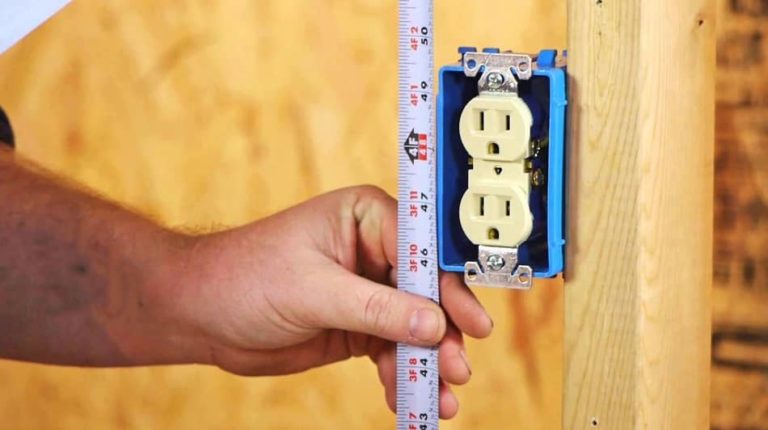What Size Lumber Is Best for Stair Stringers? (2×12)
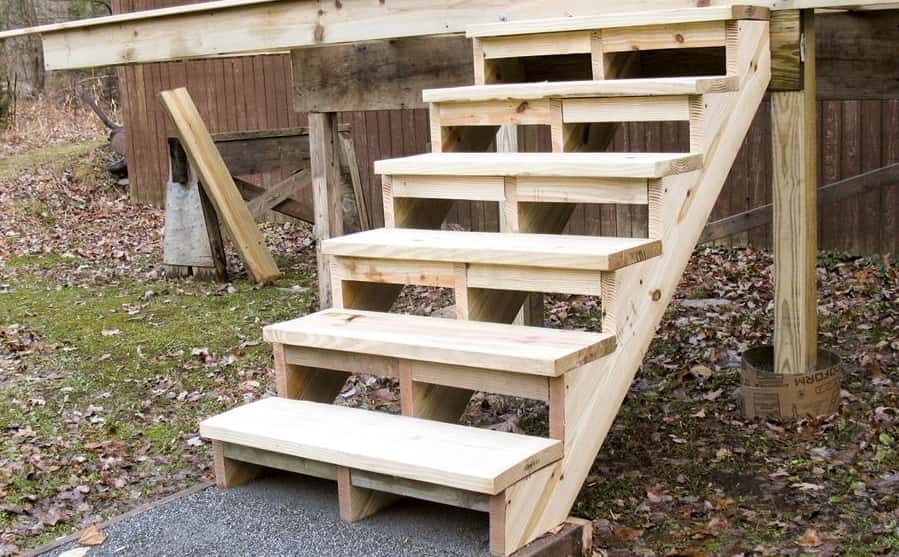
No matter if you decide to build a set of steps for your backyard deck or your home’s interior, it is important to know which lumber to choose for your stair stringers. The structural framing that supports and creates your set of stairs is called a stair stringer.
Most of the time, they are made using dimensional lumber, and then this lumber is cut into the stairs’ shape. They need to be stout to support the weight of both steps and people. The question is whether the stair stringer should be 2×10 or 2×12 in dimensions. In this article, we’ll talk about that, and explain why the right lumber size is important. So, let’s start!
Table of Contents
What Size Lumber Is Best for Stair Stringers?
So What Size Lumber Is Best for Stair Stringers? Typically, the best option for straight, high-quality, pressure-treated stair stringers is 2x12s in dimensions. Building codes accept both 2×10 and 2×12 dimensional lumber, however, it must be noted that the stair stringer must be at least 3.5 inches wide at the narrowest point.
Although this is only roughly explained, and to get a better and clearer picture of why this is so, you will need to stay with us and continue to read this article. Trust me, you will learn much more than you came for.
Speaking of stairs, it would be recommended to also read our article and see Should You Install Stair Treads or Risers First?
What Is a Stair Stringer?
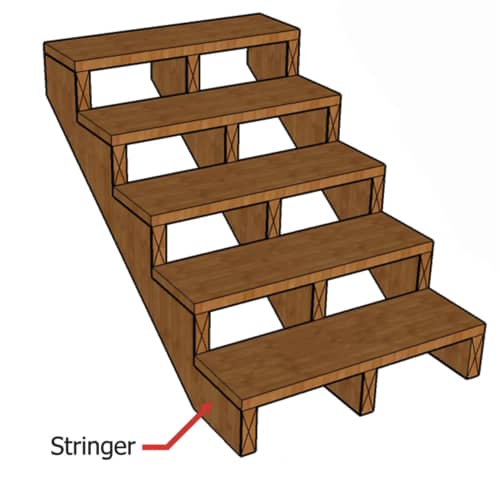
A stair stringer can be described as the framing that is used for a set of stairs. It is made by cutting and measuring notches on the board to be able to create steps. They are really important because they decide the height of a step and the depth of a tread. Typically, it is referred to as rise over run. Rise as a distance from one to another tread and run as a distance from one riser to another.
Why Is a Stair Stringer Important?
Most of the time when there are problems with stairs, the cause of the problem is the size of the notch that is cut into the stringer. If a notch is too deep for the board, a throat is created. A throat is a space between its corner and the other edge of the board and because of that, it is too narrow to hold a load.
When the throat is too narrow, it can cause stairs to fail, and people could get injured. This type of failure is dangerous because there is little warning when it occurs. Most of the time, the stairs just collapse without any warning, and that is why a stringer needs to be wide enough for the stairs.
The Right Dimensions Of Stair Stringer? 2×10 or 2×12
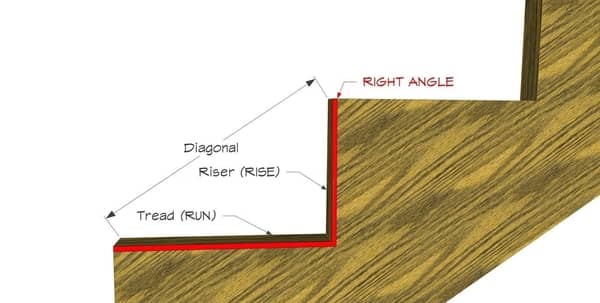
There are some specific codes when it comes to stair framing requirements but the IRC and the International Building Code do not require them and do not guide towards the type of lumber you can use for your stair stringers.
There are some guidelines that the IRC and IBC do provide when it comes to dimensional lumber. The IBC (International Building Code) says that a set of stairs should be able to hold a weight of about 40 pounds per square foot live, which means that it needs to be able to hold this weight temporarily when somebody is using the stairs. It should also be able to hold 10 pounds per square foot dead or, in other words, constantly.
The throat should be at least 2×4 (3.5 inches wide) to be able to support that kind of weight. The IRC has guidance for how high the risers can be and how deep the treads need to be. It says that the maximum height for the riser is 7.25 inches, while the minimum depth for the tread is 10 inches. A stair tread nose range should be ¾ inches to 1 – ½ inches past the front of the rise.
Even though there is no code for the size of the lumber that can be used, there is one for the tread depth and the load and riser height. It limits the dimensional lumber that needs to work as a stringer.
When you consider these limitations with the 3.5-inch rule, you can see for yourself if it is better to use a 2×10 stringer or a 2×12 one. When you know the rise and run of each step and how long the stringer needs to be, you can decide how that will affect the throat width of stringers. You should draw the first step with a square to mark the stairs’ profile. After that, you should measure from the throat’s width (the shortest point between the step’s corner and the board’s outer edge).
You should image a straight line that connects the corner to each stair’s notch and it should not be closer to the stringer’s outer edge than 3.5 inches. This ensures the proper structural integrity.
Can You Use 2×10 Dimensions For Stair Stringers?
It is acceptable to use 2×10 dimensions for your stair stringers, but then the size of your stairs will be limited. You can see which one of the dimensional lumbers will and will not work based on the standard stair height. The standard rise over run for stairs that cover 9 feet is a 7-inch rise and for the other is an 11-inch run, while for the stairs that are joining two floors when the ceiling is 8 feet high is 7.5 inches and 10 inches.
If your stringer is 2×10, you can reach with a 7-inch rise maximum tread width of 10 inches while still having a 3.5-inch throat, and that is only if you use the maximum stair tread nose that is allowed by the building code (1.25 inches). The stringer would have a 9-inch run.
You will need to cut deeper into the board and create a larger notch this way with the throat’s size reduced if you want a deeper tread. A board that is 2×10 in dimensions will maybe not be wide enough to have a larger notch and maintain a 3.5-inch throat at the same time.
You can make a notch small enough to maintain a 3.5-inch throat by increasing the tread depth (you do this by decreasing the riser height). Be aware that with this it will take a long run to reach the second level. A longer set of stairs will maybe not fit into the available space.
Can You Use 2×8 Dimensions For Stair Stringers?
Some sources may say that using 2×8 dimensions for stair stringers is acceptable, but in reality, this will probably not work. Because of the 3.5-inch rule, it is really hard to use 2×8, and it may be awkward. It is possible to have the minimum stair depth tread that is 10 inches (with 1.25-inch maximum tread nose depth) and still follow the 3.5-inch rule for the throat, but then your stair rise would have to be only 4 inches, and that may be weird and awkward.
This case may be okay for sunken living rooms or something similar where you need only a few stairs for a single room with multiple levels like that. It is not practical to connect floors like this because the total run and number of stairs then need to be almost double.
How to Properly Cut Stair Stringers With a Framing Square
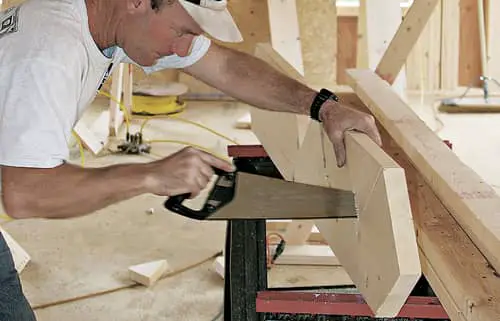
When you know the rise and run for your stairs, you can start to mark out the lines where you will cut your boards (both for 2×10 and 2×12 ones).
Firstly, put the framing square near the board’s end and leave a few inches at the end of it. Use the measurements and line them up for the run for each step and do that on the square’s longer side. Rotate it until those measurements match the number on its short side.
When both of them are lined up, trace the notch with a pencil on the square’s outer edge. Measure notch’s corner next and do it to the closest part of the board’s opposite side. With this, you will ensure that the throat is 3.5 inches wide at least. After that, slide the square down the board and trace the stairs’ shape until you reach the board’s other end.
The proper cutting is really important if you want to be sure that you will have the minimum throat width. If you cut a notch with a circular saw, that circular shape of the blades will not allow you to make a full cut at the cut’s endpoint.
You should not try to accommodate for this by cutting beyond the mark because it can cause structural weakness in the stringer. This can happen if you cut too much because that way, you can remove an additional ¾ of an inch of the material. Do it this way instead. First, cut with the circular saw and then finish the cut with a hand saw. It is even better to drill a ¼ inch hole at the notch’s corner and then cut to the hole.
Factors That Can Impact Stringer Size
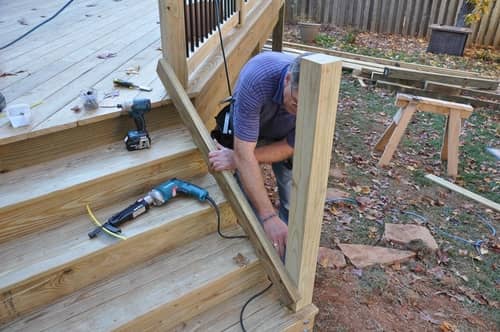
When you are choosing lumber that you are going to use for your stair stringers, there are different elements that you should consider like wood quality, type, span, design, number of the stringer, and also the cost. Yellow pine is the most used wood for stair stringers, but you can also use hardwoods like maple, oak, walnut, ash, and hickory. They offer strength that is superior to the standard pine boards.
Standard pine is five times cheaper than these types of wood. Stringers that are made of hardwood only make sense if you can see the stringers. That is why you want to use hardwood’s aesthetic appeal.
Engineered wood is also strong, and some companies even offer it for stair stringers. When you are selecting lumber size, span makes a difference. If your stringer is 2×12 and has a wider throat, it will require less support than a 2×10 one with a 2.5-inch throat. This makes a difference if there is a functional open area under the stairs.
It would help to consider how wide your stringer is depending on how the rest of the home supports them. There are stairs that are in between two interior walls, and this way, they have a big amount of support from the house framing.
A set of stairs with one or two open stringers will need more strength because it does not have that kind of support. When this is the case, it makes more sense to use a 2×12 board for stair stringers. When there is a living space under the stairs, it makes sense to use a 1×10 stringer because it can give a couple of inches more for the headroom.
It is also important to consider quality. Wood is a natural building material, and, normally, boards have different strength qualities. You need to look for boards that are in good condition with few knots if you want to have quality lumber for stair stringers. A knot that will be in the throat of one of the notches will dry out and make the stairs structurally unsound.
You should also remember that there is a difference in cost between 2×10 and 2×12 boards for stringers. At Home Depot, a 2×10 12-foot board costs about $20 and a 2×12 about $28. Most stairs use three stair stringers, so you will feel the difference in cost if you choose a more expensive option.
What Is The Right Lumber Size for Deck Stair Stringers
The difference between standard interior stringers and deck stair stringers is the type of wood. Pressure-treated wood is used for deck stair stringers, and in other ones, standard wood is used in other ones. This treatment makes the wood more resistant to pests and weather, but it does not make the lumber stronger structurally.
Deck wood is exposed to weather, and it can cause wear that can impact the structural integrity of the lumber. That is why most pressure-treated deck stair stringers that are precut use 2×12 lumber for long and short spans. Cedar is stronger and more durable than lumber that is pressure treated, and that is why it is also an option for deck stairs. Cedar stringers that are precut use 2×10 boards most of the time.
For those who want to know more, be sure to read What Is the Standard Stair Tread Thickness?
Final Thoughts
The structural integrity of stair stringers is important, so it is best to be more cautious and use 2×12 lumber. Even though it is a bit more expensive to use this type, it is also better to be safe and to save money that you may need to give if certain failures occur.
It is advised to use a 2×12 board for stair stringers unless you need space beneath the stairs if you have living space there. When walls support a set of stairs on both sides, you can use 2×10 stringers because of the walls’ additional support that they give to them. If you are not building a cedar deck, use 2×12 stringers for deck stairs. I hope that this article has helped you and if you have additional questions about this topic, be sure to contact us.





